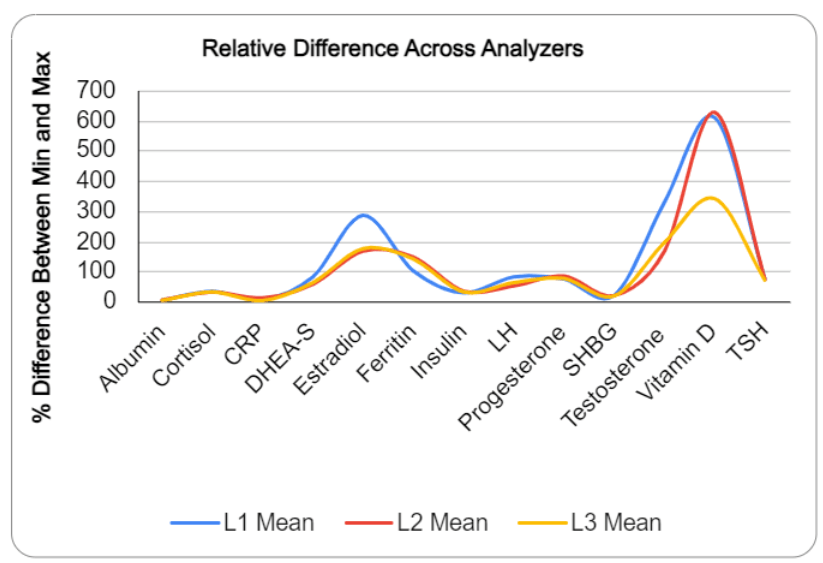Last updated: March 22, 2024
9 mins read
At SiPhox Health, accuracy isn’t just a goal—it’s a commitment. Every blood test we conduct is rigorously vetted in labs that boast CLIA certification and CAP accreditation. Furthermore, our clients frequently validate their blood test results against industry giants like Quest and LabCorp, reporting consistent positive correlations (see here, for example). Yet, the realm of clinical lab testing is inherently nuanced, and despite our best efforts, variations can occur.
The Precision Paradigm
Given that a whopping 70% of medical decisions hinge on lab tests, the stakes for accuracy are high. However, despite our (and others’) best efforts, variance has widely been accepted as commonplace in laboratory testing with lab errors having a reported frequency of 0.012–0.6% of all test results. [1]
At SiPhox Health, we’re committed to transparency and excellence throughout our product’s development. Our collaboration with CLIA-certified and CAP-accredited labs ensures our tests undergo rigorous validation against traditional venous draws. Despite this, it’s important to recognize the inherent variability within laboratory testing. Instrument variations, calibrator differences among reagent manufacturers, and unique lab reference ranges introduce a degree of variability. Unlike some in the at-home diagnostics field, we openly discuss the limitations of our technology, acknowledging that discrepancies can occur between labs, especially on immunoassay systems. A recognized industry standard accepts up to a 15% variation in results, known as the coefficient of variability, even when analyzing the same blood sample on identical machines. For a detailed look at the acceptable ranges for each analyte, visit this link. State-of-the-art equipment notwithstanding, minor calibration differences or reagent quality issues can lead to variances in outcomes.
The challenge of ensuring accurate blood test results is heightened by the use of different blood analyzing machines, such as Beckman or Abbott (the 2 leading diagnostic device manufacturers), which can lead to discrepancies in test outcomes. This article delves into the complexities of lab testing, highlighting the significant role that errors at various stages—before, during, and after analysis—play in affecting the precision of lab tests. Notably, many of these errors occur in the preanalytical phase, before the actual testing begins. The diversity of equipment used across laboratories underscores the difficulty in achieving standardized testing procedures and emphasizes the critical need for ongoing enhancements in lab practices. Our openness about these challenges underscores our commitment to quality and the continuous improvement of our services, ensuring we provide reliable and accurate health monitoring solutions.
SiPhox Liquichek Analysis
Immunoassays are scientific tests conducted in laboratories to find out how much of a specific substance is present in a fluid, often used to detect levels of biomarkers in the body. The Liquichek Immunoassay Control is a product that clinical labs use to make sure their immunoassay tests are accurate and dependable. These controls have known concentration levels and are used to verify analyzer performance and calibration needs. Ideally, when using different testing machines (analyzers) to measure the same Liquichek control sample, the results should be consistent. However, this method is imperfect and variations do occur.
SiPhox Health analyzed data from Bio-Rad to see how much results can vary depending on the analyzer used across several Liquichek controls (L1, L2, and L3). We discovered that for some substances, like cortisol and insulin, the measured concentrations are fairly consistent across different analyzers. But for others, like testosterone and vitamin D, the results could vary dramatically, with discrepancies over 300% and 600%, respectively. This means that for these markers, different machines could show results that differ by more than six times, highlighting the challenge of ensuring uniformity in immunoassay testing across different equipment. (Note: the number of data points varies for each biomarker.)
Human Error
The inherent nature of at-home self-testing introduces a greater likelihood of human error compared to traditional sample collection methods. Common issues contributing to errors include insufficient sample quantity, contamination, and damaged samples (ex. smeared, hemolyzed), all of which are frequently cited as reasons for discrepancies in test results. To help counteract these potential sources of error, SiPhox Health provides free phlebotomy calls and recommends following specific collection guidelines:
- Circulation is important. Instead of testing immediately after rolling out of bed, drink some water, wash your hands in warm water to remove potential contaminants, do some light exercises to get the blood going, and ensure that your hands are warm. Collecting your sample while standing up can let gravity do some of the work.
- Use proper pricking technique. After wiping the fingertip with alcohol, let the residual disinfectant air-dry for about 30 seconds. If you have callused fingertips, try to find an area on the finger that is softer. Press the lancet down firmly until you hear a click and feel a pinch.
-
Collecting the sample. Flip the hand over and use your other hand to massage the pricked finger, starting at the knuckle and gently gliding down toward the fingertip until a large drop is formed. Droplets should be large enough to drip off the fingertip. Collect four large drops in one square before moving to the next. Don’t take too long to collect one square since this could lead to poor absorption and serum separation.
- Trouble collecting enough blood? SiPhox Health is releasing a patented finger pump!
- Shipping the test. Leave the card on the table for 30 minutes to an hour until it is completely dry to avoid smearing. Make sure to register your test, as unregistered tests cannot be analyzed by the lab. Samples are viable for 14 days, so ship them off in a timely manner to accommodate for transportation times.
Capillary Vs Venous
Capillary sampling has long since been used by the medical profession for those with difficult venous access, such as neonates, having shown a strong correlation with more traditional methods. [2] SiPhox Health is at the vanguard, now utilizing this technology as a less invasive but equally reliable alternative to traditional venous draws, allowing for at-home collection without sacrificing accuracy. Our laboratories have undertaken rigorous validation studies comparing capillary samples directly with venous draws ensuring the reliability and accuracy of our results are upheld.
Understanding Natural Variabilities
Some biomarkers are subject to natural variation. Understanding these inherent variations is crucial for accurate health assessments. For example:
- Cyclical Biological Patterns: Our hormonal landscape is dynamic, with cortisol and testosterone levels ebbing and flowing with the day’s rhythm. Other hormones such as TSH, estradiol, FSH, progesterone, and LH experience frequent fluctuations as well. [3]
- Influences of Daily Living: The rhythms of our daily activities, including dietary habits, physical activity, fasting, and sleep patterns, significantly sway our biomarker levels.
To mitigate the impact of these natural oscillations, we recommend consistent, periodic testing. A morning fasting test, ideally at a consistent time after waking up with every test, is recommended to standardize results and mitigate daily fluctuations.
Many biomarkers, including those mentioned, are influenced by daily biological cycles and lifestyle factors. These variables mean that for a truly comparative analysis, simultaneous blood draws across different laboratories would need to be conducted at the same time to detect true result errors.
For analytes like Vitamin D and Testosterone that are not commonly measured, there exists a broader industry issue: differing results across laboratories based on the specific instruments used, such as those from Beckman, Abbott, or Roche. This variation underscores a broader industry issue regarding uniformity in testing outcomes.
At SiPhox Health, we’ve dedicated ourselves to ensuring our tests’ repeatability and validity, particularly against traditional venous draws. Our extensive internal studies, conducted during our product’s alpha phase, have confirmed that our measurements are consistent and responsive to changes in lifestyle and supplementation. This robust validation process underscores our commitment to providing accurate, reliable health monitoring solutions that reflect the dynamic nature of human biology.
The following is data from one of our clients shared with permission illustrating the responsive nature of blood tests to lifestyle events:
Data shared from a client with permission
In general, some of these measurements work better as serial measurements because one is able to establish a baseline and then see deviations. Right now, doctors rely on single measurements because of logistical issues. In reality, a single measurement of many biomarkers contains a lot of uncertainty because they can change easily.
Embracing the Complexity
Acknowledging these factors doesn’t undermine the value of blood tests; rather, it highlights the importance of context, serial measurements, and choosing reputable labs like SiPhox Health. We’re transparent about the inherent challenges we face and committed to pushing the boundaries for accuracy.
Moving Forward
Variability in lab results is a known entity, yet it doesn’t detract from the utility of these tests. Instead, it underscores the need for careful interpretation, consistency in testing conditions, and ongoing technological improvements. SiPhox Health is leading the charge, ensuring that you can access reliable, precise health insights from the comfort of your own home, this year we plan to fully replace our current ADX collection card-based kits with our superior SiPhox Home readers – the same accurate results with quicker turnaround. Our goal? To empower you with the information you need to make informed health decisions, today and into the future.
Disclaimer: If you have any medical questions or concerns, please talk to your healthcare provider. The articles on the SiPhox Health Hub are underpinned by peer-reviewed research and information drawn from medical societies and governmental agencies. However, they are not a substitute for professional medical advice, diagnosis or treatment.
References





